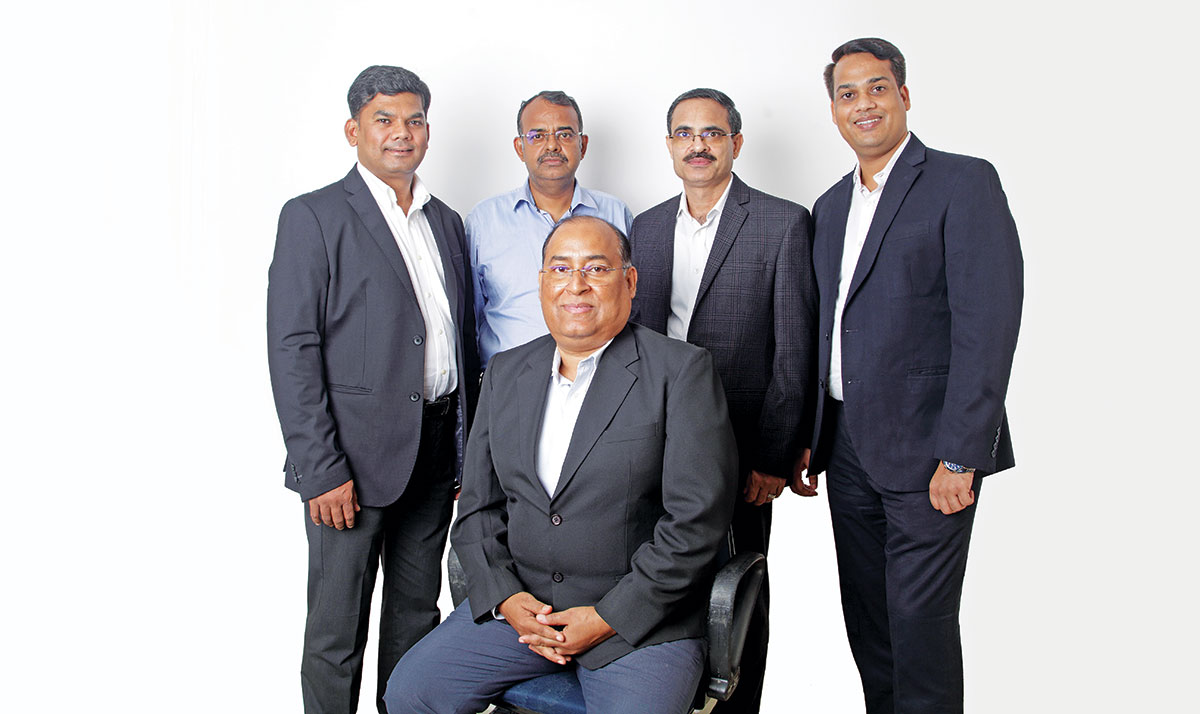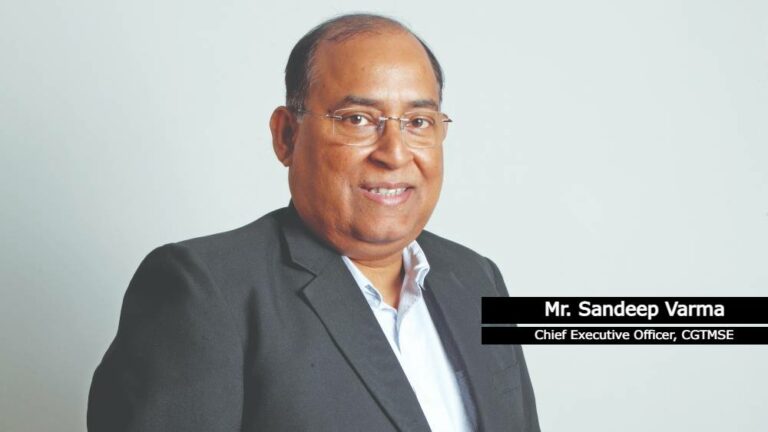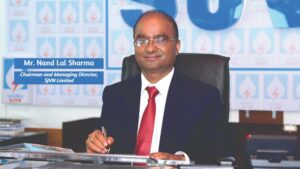Credit Guarantee Fund Trust for Micro and Small Enterprises (CGTMSE) was jointly set up in July 2000 by Ministry of Micro, Small & Medium Enterprises and SIDBI with an initial corpus of `2,500 crore (out of that SIDBI’s contribution was `500 crore) which was increased to `7,500 crore with an additional `5,000 crore contributed by the Government of India. It was launched to strengthen credit delivery system and to facilitate flow of credit to the MSE sector, create access to finance for unserved, under-served, underprivileged and new generation entrepreneurs.
The scheme provides a guarantee to loans up to `2 crore, of which 75 per cent is guaranteed by CGTMSE ( in some cases this goes upto 85%). At present, there are 146 member lending institutions including Banks and NBFCs under CGTMSE. As of June 30 2022, 61.13 lakh guarantees involving `3,35,321.59 crore were approved since inception. CGTMSE has recorded a significant 52 per cent jump in loan guarantees in the financial year 2021-22. `56,172 crore guarantees were approved under the scheme in FY22, up from `36,899 crore in FY21. The beneficiary count stood at 7.17 lakh in FY22, 8.35 lakh in FY21, and 8.46 lakh in FY20.
Its importance can be understood by the fact that Finance Minister Nirmala Sitharaman in her budget speech this year mentioned its role and announced that “to address the growing credit requirements of MSMEs through CGTMSE, it will be revamped with the required infusion of funds. This will facilitate additional credit of `2 lakh crore for micro and small enterprises and expand employment opportunities.”
Mr. Sandeep Varma, Chief Executive Officer, CGTMSE, a senior officer of SIDBI, has been at the helm of affairs for past 2 years. Under his guidance and dedicated focus, CGTMSE has undergone transformative reforms with leveraged technology to expand the scope of its schemes to uncovered segments. Leading a very young enthusiastic team Mr. Varma has many innovative ideas and working relentlessly to execute them. It all is visible when he speaks. Indian Economy & Market reached out to him, to piece together the organisation’s objectives, achievements and new initiatives in detail.
“Our dream is to have something to offer to every small borrower”
How is the CGTMSE enabling environment for the MSE sector?
It is a well-documented fact that one of the basic problems of the MSME segment is the availability of collateral security. Sometimes overleveraging also results; like whatever you have is already used but to grow you need more loans. In that situation it becomes difficult to get fresh loan because the collateral security value gets diluted. Banker’s comfort level starts diminishing. RBI has issued guidelines that loans up to `10 lakh loan has to be without collateral security. That has to be collateral free. But beyond decision to take collateral for loans above `10 lakh is left to the banks. CGTMSE comes into the picture for giving comfort to banks for extending collateral free loans. The reason of setting of this organization was to facilitate collateral security free lending to MSMES. That is our basic objective.
That means you enter only after 10 lakh?
No, as per RBI Guidelines, for loans up to 10 lakh you cannot take collateral but in the same guideline it is also mentioned that alternatively they can use the GGTMSE window. What I mean to say is that with bankers for loans above `10 lakh an option is available. However, many times they may ask for collateral and if the borrower does not have it then the deal breaks off. So there our role becomes more important. If collateral is not available and banker’s confidence is not there then we create an enabling environment. It comes as a credit enhancement. Secondly, when we enter, the rating of credit improves. Borrower’s rating improves one or two notches. So it is possible that without the security it might be falling into non investible grade but the moment guarantee is there, that too a sovereign guarantee – a guarantee which replaces the collateral security – the entire scene changes.
It means borrowers don’t approach you directly?
No, it is a two tier structure. We don’t go out to borrower because we don’t lend. Our role is to ensure comfort to the bankers. So when a borrower goes to bank and says I don’t have any collateral and will take CGTMSE guarantee or this can come from banker also that since you don’t have collateral and without that I am not comfortable so there is a guarantee available and if you are willing to pay the cost then we’ll take that. So it can happen either way. When banker approaches us we issue the guarantee and once the fee is received the guarantee becomes live.
KYC has to be done by banker. All, project appraisal and due diligence, they have to do. Once the bank is knowingly taking a call on the borrower then it does not leave much space for us to do entire thing all over again. If the banker feels that CGTMSE scheme is not going to help either him or the borrower he will not proceed further. If a banker is very confident that even if there is no collateral this account may not turn into NPA then he may even decide not approach us. Suppose there is a known borrower with a very good history. He has taken 4 loans and paid in time; now he is taking a fifth loan. In that case the banker will tend to have a lot of confidence and he may not come to us.
But bankers may avoid taking the cumbersome process?
Banks are well aware about the scheme and whenever they feel they come to us. Only because security is available they don’t give loan because recovery can be done from our side but the contamination in portfolio has to happen. So no banker in his right senses would give a loan only on the basis of guarantee if he is not fully convinced.
Recovery involves lot of costs and it doesn’t mean the financial cost alone. It has HR cost also. So you are replacing all this with government security. Also the guarantee provided by us has no risk weightage because it is sovereign guarantee. If we look at the bank’s point of view then it improves their CRM. It can help them for further lending as provisioning is not required. Actually it is a win-win situation for all. Borrower is getting benefitted. Now he has a tool in his hand. He can say I’ve no collateral but I want to take CGTMSE guarantee. I am willing to pay that cost. MLIs have an advantage. The guarantee or security from assets gets shifted to institutional guarantee which is a huge improvement. This is how we have been helping MSEs. As on date we have issued `3,35,000 crore worth of guarantee in 22 years. About 60 lakh odd borrowers have been covered under the scheme.
How CGTMSE supports the first generation entrepreneurs to realise their dream of setting up a unit of their own Micro and Small Enterprise (MSE)?
Frankly speaking, CGTMSE, in a big way, is helping the first generation and Greenfield entrepreneurs who do not have any back up. When we see our data we feel proud that about 50 per cent of the borrowers in our fold are either first generation or new to banks. I mean, banks don’t have their credit history. For the banks the Guarantee becomes a handy tool. He feels that since the proposal looks attractive and even if there is no credit history if the account becomes bad then also he will get his money back. Same logic goes to CC enhancement, Term Loan, or it can be a combination of the two, and even it can be Composite Loan and working capital also. So we provide guarantee for all.
Many a time the collateral is too big, may be worth `10 crore but the borrower needs only a loan of `50 lakh. In that case he may plan that when I’ll take big sum then only I’ll use this for collateral. In that case also CGTMSE could be handy. We can provide guarantee for that amount. That is the reason for first generation it becomes very good tool. For second and third generation entrepreneurs bankers have enough conviction. If you see the international agencies in Japan and Korea, everywhere it works and it works very smoothly. Security scarcity is everywhere. Either borrower has no capability or his security value is diluted. At the same time when we want a borrower to grow, go for diversification, modernization, expansion then we know the collateral is not expanding in that proportion. Then what do you do as banker?
What is your share in the total credit to MSMEs?
If you compare our share in the total credit to MSMEs then it would appear less. It is about 7-8 per cent which should go up to 25 per cent. But if you see how it has fared over a period of time then till 2018 it had been `18,000-19,000 crore worth of guarantee per year that we used to approve. Then we made certain changes and 2018 onwards it has seen a quantum jump. It increased to `30,000 crore then `45,000 crore. During Covid it saw some dip and was `36,000 crore in FY 21. Last year we ended up at `56,000 crore. That was the first time in CGTMSE’s history that we crossed the milestone of `50,000 crore of Guarantee. This year again, till June we have grown 50 per cent. Now the same `18,000 crore we used to do in a year, we do just in one quarter. In this FY during the first quarter we already have done `20,000 crore. If you extrapolate that then `80,000 crore we may touch easily.
Don’t you think large number of borrowers is unaware of your schemes?
Now we have travelled a long journey – 22 years. We have digital and social media platform so the information regarding our role is spreading faster. Sometimes borrowers come directly to us. We educate them that we don’t provide loan but we have schemes to facilitate the process if you approach bank. Earlier people were unaware about our role and objectives. Initially we took baby steps. Out of our total guaranteed sum of `3,35,000 crore, about fifty per cent we did only in last 4-5 years.
CGTMSE has introduced a new “Hybrid Security” product. Can you explain in detail how it functions?
In fact we have been bringing about continuous modifications in order to cover large number of MSEs and improve the ease of delivery. In 2018 many major policy changes in the credit guarantee products were introduced. As I said, suppose a borrower has collateral of `50 crore but needs only `50 lakh but we can also find its reverse. Suppose someone needs loan of `one crore but he has only `10 lakh worth of collateral. In that case our earlier scheme has nothing to offer him. It said that if you have absolutely zero collateral then only CGTMSE will come to your rescue. But if you have collateral, of whatever value, then CGTMSE will not be available to you. We felt that it was not very justifiable because where such borrowers should go? So we introduced a scheme called Hybrid Security model which covers such borrowers. Under this model we cover the cases where collateral is not sufficient to cover the entire loan. What do we do in such cases? Whatsoever collateral you have that will be knocked off from the credit amount and we will provide 75 per cent of the unsecured portion. Earlier such borrowers were completely out of our purview.
Any other innovative schemes you have introduced recently?
Yes, we came out with some more such innovative schemes. Like, earlier we used to take renewal fee on the sanctioned amount. For example, if the amount was `two crore then fee was calculated on that amount for the entire period. Later we realized that it didn’t reward the good paying customers. It was not justified to treat them on the same lines of irregular payers. So we changed it to the reducing balance model. That means now renewal fee is calculated only on outstanding balance. Thus we started rewarding good paying customers. It was a massive change. Secondly, we also increased quantum of guarantee. In fact we took several operational steps in 2018-19.
In case the lender fails to discharge its liabilities how the Guarantee Trust would take over?
It is only when someone fails to repay, we enter into play. For the rest time it is like life insurance.
First, the bankers need to mark the account as NPA. Then use all the legal recourses you could initiate; whatsoever it may be, or file Civil Suit. After that you come to us. It is a two stage claim settlement. First, we settle their claim for 75 per cent of the guarantee value. Then either the legal action is completed or they certify that there is nothing to recover. Accordingly, either on the completion of legal action or 3 years from the date of first settlement, we clear 25 per cent balance amount also. The rationale behind 3 year time period is that there is a moral hazard. It should not happen that just because 75 per cent is there no action is taken. Like highest guarantee approval, last year also saw the highest amount if claim settlement.
How is your relationship with MLIs?
We make sure that once commitment is made then we must honour it. Our guidelines are very clear – you have to give us certain information and we will settle the claim. We have to show the banks that we are good to settlement also otherwise they will not come to us. We get enough revenue from the sources mentioned earlier to take care of all our liabilities. We also realize that settling the liability is the precursor of getting more business. Many MLIs are approaching to come under our ambit. We do certain formalities and include in our list of MLIs. Once they become a member then lending done by them becomes eligible to be covered under CGTMSE. We have added many NBFCS, Fintechs, Small Finance Banks. In February we added Scheduled Urban Cooperative Banks because we realized that if we have to reach out to MSEs then we can’t ignore these players. Now we are trying to add MFIs (Micro Finance Institutions). We also feel that if we have to do area specific intervention then they can prove to be good vehicle.

What is your source of revenue?
Our guarantee model is based on corpus cum fee model. It is difficult to survive only on fee model because you get a very small fee amount. Government has shown faith in us and over the time a corpus has been created. Right now it is `7500 crore. Out of that `7000 crore has been provided by the government and `500 crore by SIDBI. So we have two sources – Fee plus income generated from the corpus like Fixed Deposit etc. Liquidity and safety are the two mantras we follow while investing our corpus. So far there has not been a single occasion where we would have felt scarcity of funds. We have never even touched our corpus. It has been created very nicely and financially ours is a very sound organization.
You are also approaching State governments.
Yes, that’s correct; we want to collaborate with them. The rationale is although we provide 75 per cent coverage but many a time we realize that for many Micro and Small Enterprises the primary security has a peculiar nature. The nature of primary securities are such that they have less realizable value and bankers may feel that although they would be able to recover 75 per cent but our 25 per cent will not be recoverable. If in such a scenario, lenders become risk averse, the ultimate losers are the borrowers. Now we can’t increase our guaranteed value so we decided to rope in a partner who could take care of the rest 25 per cent.
We have tried to convince States that in high prioritize area they can make their schemes better with our association. Less developed places in the State can be offered separately designed liberal schemes to promote industry or even encourage entrepreneurship. This cannot be possible with the mother scheme because it has to be non-discriminatory and non-discretionary. Our proposal is simple – provide us some funds that we would manage separately. I’m indeed happy to inform you that Government of Tamil Nadu is the first State with which we have entered into collaboration and the pilot Scheme has been launched. Next, we are going to ink an MoU with Govt of Assam shortly. Talks are in advanced stage with some other state governments also.
Any new initiative you are planning?
In fact, many. We have to keep changing and we have to meet the aspirations and expectations of MSMEs. First, our fee structure is slab wise. Like, up to `5 lakh we charge one per cent. From `5 to 50 lakh it is 1.3 per cent and for more than `50 lakh it is little more. Ours is a Trust and we are not working on any profit making motive. We just want to remain afloat. So we are exploring whether rates can be further reduced. We are planning it in such way that a smaller slab gets more benefit.
We are also in conversation with World Bank to promote Roof Top Solar for MSMEs. Like an existing unit if needs loan to install Solar Roof Top. Since its existing assets are already mortgaged we are contemplating whether we can come in as guarantee partner. So with these innovative products we are trying to come out of traditional lending process to make it an institution which has multi bouquet and everyone finds at least something to suit his needs. Our dream is that we should have the maneuverability that for every small borrower there is something to offer to him.
Do you have any guidance for this year?
Majorly on four fronts we are working right now with `75,000 crore target this year – change in platform structure, rationalization of guarantee fee, engaging state government and guarantee for loan for solar rooftop panel, fee. To achieve this we are all geared up with upgrades and a robust support system. We are revamping our technical platform to make it fully automated. I want MLIs to have ease of doing business while dealing with us. We propose to make the system very robust with API integration. We want the entire guarantee mechanism to be on automated basis MLIs should get everything updated without coming to us. It will give lot of comfort to them and us also to monitor how their guarantee portfolio is behaving. So on one side we are working on policy level and on the other to support those changes we are changing the platform in which we work.
How you are contributing to Atmanirbhar Bharat?
A study was conducted by a professional agency which came out with some interesting facts. It says that the businesses associated with us have performed wonderfully better compared to the others. So CGTMSE on its part is deeply committed to pursuing government’s development agenda by accelerating guarantee coverage and providing the requisite stimulus for institutional lending to the MSEs. As part of its efforts to broaden the canvas, we’ve also already increasing the number of MLIs. These broadening would give further impetus to entrepreneurship and flow of credit to MSEs. I personally feel that a lot can be done still for the women entrepreneurs and for the people belonging to socially weaker section of the society. We are working on proposals to provide them additional benefits. Ultimately our aim is to make an inclusive society.
CGTMSE on its part is deeply committed to pursuing government’s development agenda by accelerating guarantee coverage and providing the requisite stimulus for institutional lending to the MSEs. I personally feel that a lot can be done still for the women entrepreneurs and for the people belonging to socially weaker section of the society. We are working on proposals to provide them additional benefits. Ultimately our aim is to make an inclusive society.






















